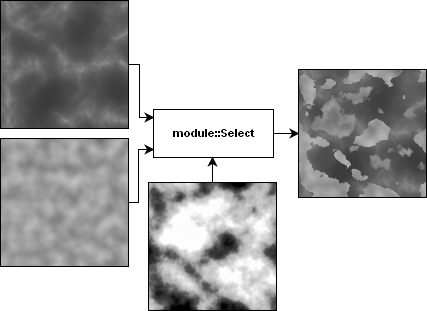Navigation menu

A portable, open-source, coherent noise-generating library for C++
noise::module::Select Class Reference
[Selector Modules]
#include <select.h>
Inheritance diagram for noise::module::Select:

Detailed Description
Noise module that outputs the value selected from one of two source modules chosen by the output value from a control module.

Unlike most other noise modules, the index value assigned to a source module determines its role in the selection operation:
- Source module 0 (upper left in the diagram) outputs a value.
- Source module 1 (lower left in the diagram) outputs a value.
- Source module 2 (bottom of the diagram) is known as the control module. The control module determines the value to select. If the output value from the control module is within a range of values known as the selection range, this noise module outputs the value from the source module with an index value of 1. Otherwise, this noise module outputs the value from the source module with an index value of 0.
To specify the bounds of the selection range, call the SetBounds() method.
An application can pass the control module to the SetControlModule() method instead of the SetSourceModule() method. This may make the application code easier to read.
By default, there is an abrupt transition between the output values from the two source modules at the selection-range boundary. To smooth the transition, pass a non-zero value to the SetEdgeFalloff() method. Higher values result in a smoother transition.
This noise module requires three source modules.
Public Member Functions | |
| Select () | |
| Constructor. | |
| const Module & | GetControlModule () const |
| Returns the control module. | |
| double | GetEdgeFalloff () const |
| Returns the falloff value at the edge transition. | |
| double | GetLowerBound () const |
| Returns the lower bound of the selection range. | |
| virtual int | GetSourceModuleCount () const |
| Returns the number of source modules required by this noise module. | |
| double | GetUpperBound () const |
| Returns the upper bound of the selection range. | |
| virtual double | GetValue (double x, double y, double z) const |
| Generates an output value given the coordinates of the specified input value. | |
| void | SetBounds (double lowerBound, double upperBound) |
| Sets the lower and upper bounds of the selection range. | |
| void | SetControlModule (const Module &controlModule) |
| Sets the control module. | |
| void | SetEdgeFalloff (double edgeFalloff) |
| Sets the falloff value at the edge transition. | |
Protected Attributes | |
| double | m_edgeFalloff |
| Edge-falloff value. | |
| double | m_lowerBound |
| Lower bound of the selection range. | |
| double | m_upperBound |
| Upper bound of the selection range. | |
Constructor & Destructor Documentation
|
|
Constructor. The default falloff value at the edge transition is set to noise::module::DEFAULT_SELECT_EDGE_FALLOFF. The default lower bound of the selection range is set to noise::module::DEFAULT_SELECT_LOWER_BOUND. The default upper bound of the selection range is set to noise::module::DEFAULT_SELECT_UPPER_BOUND. |
Member Function Documentation
|
|
Returns the control module.
|
|
|
Returns the falloff value at the edge transition.
By default, there is an abrupt transition between the output values from the two source modules at the selection-range boundary. |
|
|
Returns the lower bound of the selection range.
|
|
|
Returns the number of source modules required by this noise module.
Implements noise::module::Module. |
|
|
Returns the upper bound of the selection range.
|
|
||||||||||||||||
|
Generates an output value given the coordinates of the specified input value.
To determine the number of source modules required by this noise module, call the GetSourceModuleCount() method. Implements noise::module::Module. |
|
||||||||||||
|
Sets the lower and upper bounds of the selection range.
|
|
|
Sets the control module.
This method assigns the control module an index value of 2. Passing the control module to this method produces the same results as passing the control module to the SetSourceModule() method while assigning that noise module an index value of 2. This control module must exist throughout the lifetime of this noise module unless another control module replaces that control module. |
|
|
Sets the falloff value at the edge transition.
By default, there is an abrupt transition between the values from the two source modules at the boundaries of the selection range. For example, if the selection range is 0.5 to 0.8, and the edge falloff value is 0.1, then the GetValue() method outputs:
|
The documentation for this class was generated from the following files:
- select.h
- select.cpp
© 2003-2005 Jason Bevins

The libnoise source documentation was generated by doxygen 1.3.9.1